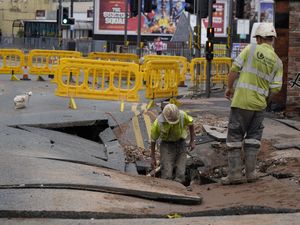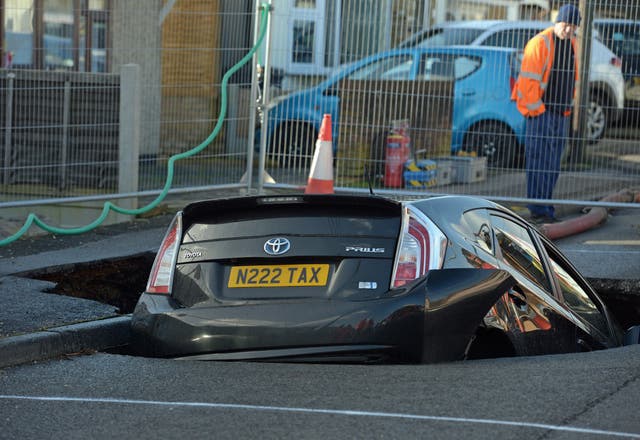What is a sinkhole and why do they happen?
People living in 30 properties in the Surrey village of Godstone have been evacuated from their homes after a huge sinkhole appeared on Monday.

A huge sinkhole that swallowed parts of a high street in Surrey could mean residents are unable to return to their homes for months.
People living in 30 properties in the village of Godstone were forced to evacuate their homes as a 100-metre police cordon was put in place on Monday.
SES Water later said one of its main pipes had burst underneath the road.
The emergence of sinkholes has not been confined to this small area of Surrey.

In recent years, several have appeared across the UK, causing damage to infrastructure and forcing costly repair works.
– What is a sinkhole?
A sinkhole is a depression in the ground’s surface caused by erosion of the underlying rock, according to the British Geological Survey.
They often appear saucer-shaped but can look like cones, cylindrical potholes or deeper shafts upon formation.
Sinkholes vary dramatically in size and depth – some span less than a metre, while others stretch hundreds of metres.
By Tuesday the Godstone hole was estimated to have grown to at least 65ft (20m) long.
The depth of the sinkhole in Surrey is unknown because the road and neighbouring buildings obscure its true size.
– Why do they happen?
While sinkholes can open up for several reasons, their formation is usually because of a place’s geology.
However, human factors can be a cause, and the British Geological Survey cites broken water mains, modified drainage and surface water diversion as reasons for subsidence.
More commonly, sinkholes develop when highly soluble rocks like chalk or limestone dissolve after reacting with acidic rainwater.
The soluble rocks form karst – a landscape associated with underground caves and sinkholes.
If the soluble rock lies beneath another layer of rock, it can be slowly dissolved under the surface without presenting immediate evidence of depression before collapsing suddenly.
– Where have other sinkholes appeared?
In December 2024, days after Storm Bert caused flooding across the region, a large sinkhole appeared on a housing estate in South Wales.
The sinkhole, which was caused by the collapse of a culvert – a structure that channels water past an obstacle – appeared without warning at Nant Morlais, Pant, near Merthyr Tydfil, and led to the evacuation of about 30 homes.
After the initial collapse the hole continued to expand, and the road on the housing estate began to crack, sparking fear among people for the safety of their properties.
Three months earlier, in September 2024, a sinkhole formed on the pitch of AFC Wimbledon’s Cherry Red Records stadium, after the ground was hit by extensive flooding when the nearby River Wandle broke its banks.

Wimbledon were forced to reschedule a League Two fixture with Accrington Stanley after the hosts failed to secure a replacement venue at short notice.
The side’s League Cup tie with Newcastle United was postponed before the game was switched to St James Park because the surface was deemed unusable.
The club were forced to pump more than 100,000 litres of water from their ground and repair the sinkhole-damaged pitch before they could return to home league action against Carlisle United the following month.
On a less significant scale, in January 2023, the appearance of a sinkhole in south-west London led to a road being closed and subsequent travel disruption.
The hole, which opened up on Kingston Road, Teddington, led to a road closure between Ferry Road and Kingston roundabout.
Richmond County Council said the opening was caused by a Thames Water main pipe failure, and the water company was tasked with repairing it.
– Where in the UK do sinkholes typically form?
While sinkholes can open up across the UK, they are especially likely to form in areas built on limestone rock, such as the Mendips parts of Wales, the Peak District and the Yorkshire Dales.
Places built on gypsum, a more soluble material than limestone, such as Ripon, North Yorkshire, are particularly vulnerable.
– How is a sinkhole repaired and how long does it take?
The time it takes to fill a sinkhole depends on a number of factors, including its size, depth and proximity to nearby buildings and infrastructure, according to information published by the Government.
Considerations have to be made when using heavy machinery to fill a sinkhole, as the weaker sides of the formation can be prone to collapse under weight.
The area around the opening may have to be secured before direct construction on the hole can take place.
One common way of repairing sinkholes is to refill the opening with a sand and cement mix.
In rural areas it can be more sustainable to excavate down and cap off the hole with reinforced concrete.
This process is beneficial as the extent of the hole can be properly surveyed, and so the right amount of backfilling can be carried out.





